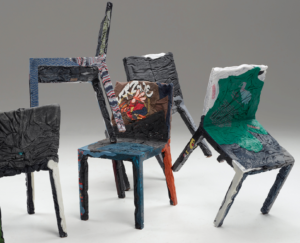week 4: remaking the way we make things

In Cradle to Cradle: Re-Thinking the Way We Make Things
This week’s reading was by architect William McDonough and chemist Michael Braungart who combine design and science that present the ways in which society would benefit from a circular economy that is inspired by nature’s abundant supply chains, with the ultimate goal of eliminating the concept of waste. They put forward the concept of ‘cradle-to-grave’ and ‘cradle-to-cradle’ design cycles which is an idea that has really inspired me to start constantly trying to seek improvement in my own designs.
Cradle-to-grave: Product is created, used and disposed of
Cradle-to-cradle: Sees waste as an eternal resource. Developing a product where all resources can be used effectively, and in a cyclical way.
The book also put forward a design framework of three principles, which I personally found quite interesting, though perhaps slightly unrealistic and idyllic.
3 principles:
1. everything is a resource for something else- everything can be designed to be disassembled and safely returned to the soil or re-utilized as high-quality materials for new products.
2. use clean and renewable energy- we should use clean and renewable energy, such as solar, wind, and other energy systems still being developed today; capitalizing on these abundant resources while supporting human and environmental health.
3. celebrate diversity- creating designs that respond to the unique challenges and opportunities of each place that they become part of so that they fit elegantly and effectively.
Although these principles do seem relatively reasonable, the reality of the large-scale changes that would have to be implemented makes them slightly naive. As a result of our irresponsible design history, there are already large amounts of products and large-scale energy systems that don’t fit this mould. Furthermore, ignorant mindsets surrounding the current environmental crisis, as well as priorities of designing for trends and financial gain, may mean designers are reluctant to make these changes.
Though I don’t think our current system can change entirely, the overall message of the reading was optimistic and the principles were insightful. I do believe that as designers it is our responsibility to find a balance between profit and ethical practice. Concepts such as downcycling where valuable components of products can be reused could be a good way to begin reusing products that are already in circulation. I also think it is key for designers to implement the cradle-to-cradle mindset as it could be revolutionary for the future of both our environment and design practice.
Designer of the week…
Berlin-based designer Tobias Juretzek works with an Italian recycling company to source unwanted clothes and with Italian furniture manufacturer Caamania and Horm to saturate them with a binding agent and compress them into chair-shaped moulds. It is currently a very hands-on, small-scale, process, but he has plans to scale up and use the pre-consumer waste streams of the fashion industry to create furniture.
The Rememberme chair was inspired by his interest in the nature and value of our relationships with the objects we own. The characteristics, details and colours of the original clothes of clothes remain visible, giving the chairs a unique and unconventional appearance, but also challenging people to think differently about waste.

http://www.tobiasjuretzek.com
References
Braungart, M. and Mcdonough, W. (2009). Cradle to cradle: remaking the way we make things. London: Vintage.
EPEA (2022). Cradle to Cradle. EPEA. Available at: https://epea.com/en/about-us/cradle-to-cradle.